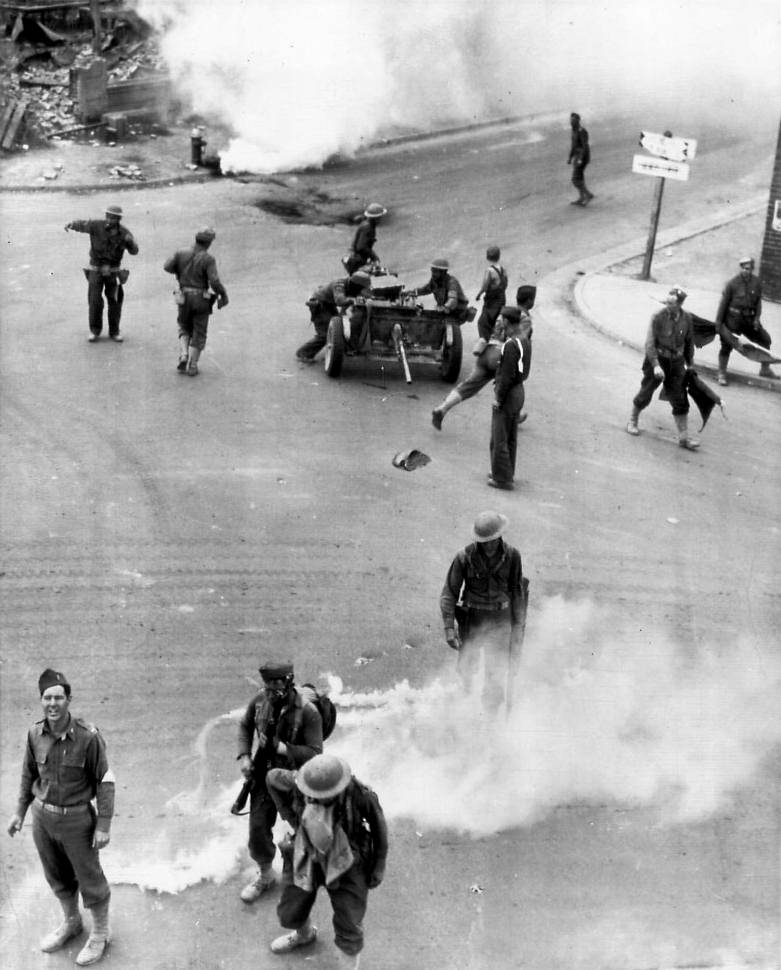
World War II: United States Renewal of Selective Service (August 1941)

Figure 1.--These newly drafted America soldiers are training just a few days before the Japanese struck Pearl Harbor, brining America into the War. If the isolations had succceeded in blocking the renewal of Selective Service, the United states would have entered the war essentially without an army. The caption to this wire service photograph read, 'The lad enjoys good fight: A neighborhood boy (to the right of the gun) gets himself into the thick of things as the 1st Division mop-up squad and antitank gun crew move over the principal street corner of Marshville, N.C. after maneuvering through a smoke screen laid by retreating 'red' forces during war gmes. The sergent (upper left) has torn pants.' Note the narrow mussel of the anti-tank gun. It could not have stopped the Panzers tht the Germns were producung at the time. The photograph was dated November 24, 1941. The 1st Division or Big Red One would be one of the most storied U.A. Army divisions of Worlkd war II.
|
|
The isolations were not silenced with their defeat over Selective Service (September 1940), Roosevelt's Third term (November 1940), and approval of Lend Lease (March 1941). The Unites States virtually did not have an army before the Selective Srvice Act was passed. And even adter it the U.S. Army was still small, untrained, and poorly equipped. This was the first step in building a 6 million man army. The 1940 Selective Service Act authorized conscription for 1 year. As a esult, the isolations staged a major effort to defeat the renewal of the act in 1941. It would be the last major effort by the Isolationists. Despite the war in Europe and Japanese advances in the Pacific, there was considerable resistance in Congress for renewing the Selective Service Act. Many mothers anhd wives wrote to their Congrsssmen complaining. The resistance to renewal was led by the Republican minority, but the draft was such a sensitive issue that they were joined by enough Democrats that renewal was in serious question. The NAZI surprise attack on the Soviet Union was another clear indicator of Hitler's orientation toward war and Germny's military capcity. Any thinking soul could reason that fighting the NAZIs with allies was essential. At the time the 1940 debate took place, the survival of Britain was in question. When the 1941 debate took place, it was the survival of the Soviet Union that was in question. The isolationists, however, again resisted the draft. They convinced themselves that War with the NAZIs was not enevitable. Failire to renew Selective Service would have meant that the men drafted in 1940 would go home only a few weeks before Pearl Harbor. hus America would have entered World War II essentially without an army. I a razor-thin Congressional vote on the eve of Pearl Harbor, the Selective Serbice Act was renwed (August 1941). President Roosevelt was with Churchill at the Atlantic Conference when the House voted to renew Selective Service by 1 lone vote. The vote was 203 to 202. There were attempts to change votes and run a a vote count, but Speaker Rayburn gavelled them down. To gain even this margin, the bill had to include a commitment not to send draftees out of the Hemisphere without Congressional authorization. [Black, p. 656.] Renewal permitted the Army to keep the 1949-41 draftees. And now to add a second year class of draftees.
HBC

Navigate the Boys' Historical Clothing Web Site:
[Return to Main American Selectice Service page]
[Return to Main isolationist page]
[Return to Main 1941 Neutrality page]
[Return to Main World War II page]
[Introduction]
[Activities]
[Biographies]
[Chronology]
[Clothing styles]
[Countries]
[Bibliographies]
[Contributions]
[FAQs]
[Glossaries]
[Images]
[Links]
[Registration]
[Tools]
[Boys' Clothing Home]
Created: 9:20 PM 8/26/2011
Last updated: 9:20 PM 8/26/2011



